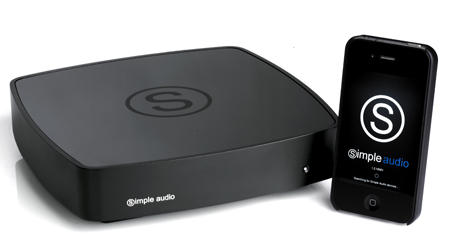What Hi-Fi? Verdict
Simple Audio offers a good alternative in the affordable multi-room system market, and while it’s not the perfect system yet, it’s definitely worth an audition
Pros
- +
Even tonal balance
- +
sound is clear, detailed and fast
- +
plays a wide range of music files, including 24-bit/96kHz
- +
compact build and good looks
Cons
- -
Control software could be more intuitive
- -
sound isn’t the last word in engagement
Why you can trust What Hi-Fi?
If you have the majority of your music collection stored on your computer, and are looking for a way to stream music throughout your house, then until recently Sonos or AirPlay were the obvious, mainstream choices.
But if you had any high-resolution content, you were out of luck. New UK-based company Simple Audio, however, could be your knight in shining armour, with its Roomplayer I and Roomplayer II multi-room set-up which can handle high-resolution 24-bit/96kHz audio.
Just in case you haven't heard of Simple Audio before, it's worth mentioning that the company was founded in 2008 by ex-Linn employees, headed by managing director Peter Murphy. Its ambition was "to create a new high-definition sound system that would open up the world of digital music for everyone".
See the new Simple Audio Roomplayer+ system review
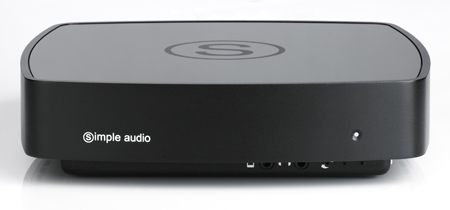
Simple Audio Roomplayer: Tech specs
The £599 Roomplayer I is the main unit, containing a built in Class D amplifier with a claimed 2x50W output. If you already have an existing system in place, with a speakers and an amp, then Simple Audio also offers the Roomplayer II – which doesn’t include the amp, and costs £499.
The Roomplayer I is a compact 5x20x20cm box, with a nice aluminium and tempered-glass finish. It might look understated, but its build quality gives it a classy and elegant look.
Also included in the box are a few helpful cables: phono-to-phono, phono-to-3.5mm, 3.5mm-to-3.5mm, ethernet and mains cables.
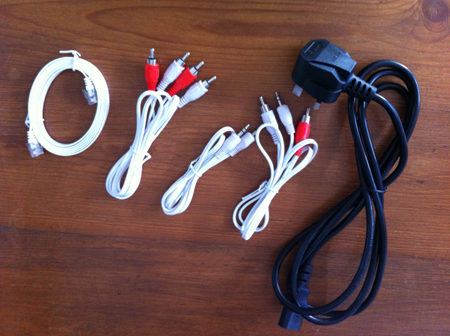
The connections are housed round the back, and comprise speaker outputs, coaxial out, optical out, subwoofer out, line-level inputs and outputs, ethernet and a USB port. There are two 3.5mm inputs hidden at the front, under the outer ledge of the Roomplayer: one for headphones, and another for connecting an iPod or other MP3 player.
One thing to note is that these inputs are quite closely placed to the ledge, so there isn’t enough space for some cables with fashionably bulky plugs. Completing the picture are LED lights that indicate power, network and pairing connections.
Simple Audio Roomplayer: Powerline transmission
Previously, if you wanted a multi-room system, you’d either have to go through the hassle of drilling holes and chasing cables into walls, or take the wireless route, which brings with it all sorts of stability issues.
Simple Audio has adopted a third system, HomePlug AV Powerline technology, which sends audio signals via ethernet over mains. It uses a fully wired network that every house already has – the mains – so installation is pretty easy. You just have to make sure that the wiring in your house is configured correctly, or the Roomplayers may not be able to communicate with each other.
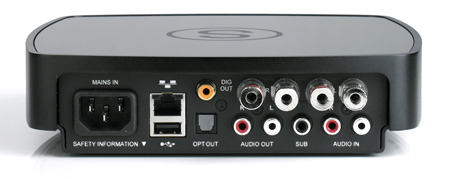
You have two choices in how you connect your Simple Audio system network to the internet. Either run an ethernet cable directly from your router to the back of the Roomplayer or, if your unit is too far away from your router, then you can use an optional Simple Audio HomePlug module (£59) instead.
If you choose the latter option, simply plug the HomePlug into a mains socket, connect it to your router via ethernet cable, and then pair it to your Roomplayer. A flashing light on the ethernet port confirms the connection.
You can use one Roomplayer on its own with a pair of speakers and that’s a neat system, but the multiroom operation is the aim here. You can connect up to ten Roomplayer units, spread across your house wherever you have speakers. All you need to do is plug them into the mains and pair up with the main Roomplayer unit.
The step-by-step pairing process is laid out in detail in the Simple Audio online manual, so we won’t repeat it here, other than to say it involves a series of button pushes using the pairing button on the players and/or the HomePlug module. Anyone who has set up a Sonos system will be familiar with the process.
Once paired, it will remember the system even when it’s turned off, so you only ever need to do it once.
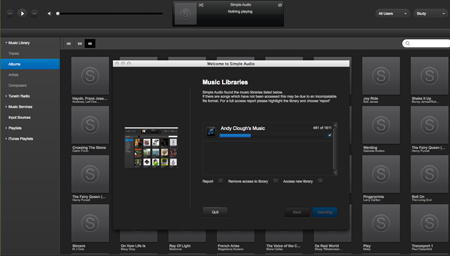
Simple Audio Roomplayer: Desktop controller
After you connect the Roomplayer to your speakers, there’s one step left – downloading the Desktop Controller (above) from the Simple Audio website.
This iTunes-like interface is the main controller for your Simple Audio system, from where you can maintain your music libraries, choose tracks, download updates, and access radio stations.
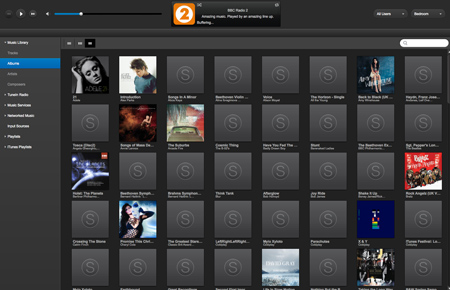
It also controls the settings for the Roomplayer units. When first opening the Desktop Controller, it will start to detect all connected Roomplayer units. You will have to pick one unit as the Master – this is the one that’s connected to your router. You can also do this manually, going to the System tab, and selecting Choose Master.
It might take a few seconds or more for the Desktop Controller to recognise all the Roomplayer units. As with the pairing process, it does require a bit of patience – but only the first time. Once all the units are recognised by the Desktop Controller, it’s quick to detect them again when you next turn your system on.
Next go to Roomplayer set-up: here you can name each individual Roomplayer, such as Living Room or Bedroom, to make it easier to identify them, and you can also adjust gain settings for each unit, which helps to equalize the sound from different sources.
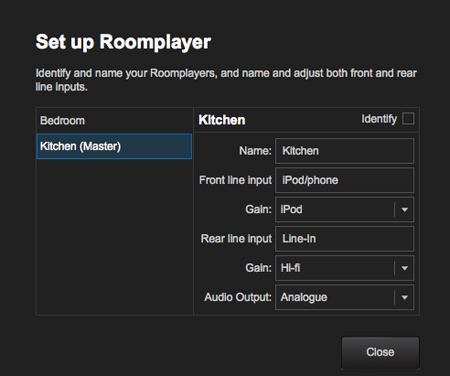
The Desktop Controller automatically detects and adds your iTunes library to its interface – this is true for any computer turned on and connected to the same network that the Simple Audio system is on.
This means that more than one Desktop Controller can be running simultaneously, but also that if you want to play music that’s stored on another computer, it has to be turned on.
If you’re thinking this means you’ll suddenly have a whole bunch of music that isn’t yours – for example, it might pick up music stored on your parents, siblings or roommate’s computer if you’re all on the same network – then you’re right. But if you’d rather keep things on the straight and narrow, you can set up individual user accounts and libraries.
Go to the Manage User tab, and you can set up individual user profiles for your own music libraries, playlists and favourite radio stations.

The Music Libraries tab shows you all the stored libraries available on your network. Here, each user can select which libraries they want access to, thereby filtering out any unwanted access to particular libraries on your network. Two tabs on the top right corner of the Controller make it easy to pick the user and the Roomplayer you want to control.
The Simple Audio system is impressive in that it supports most popular files – FLAC, WAV, AAC, Apple Lossless, AIFF, MP3 – and it also plays 24-bit/96kHz audio, although it won't handle WMA or DRM files.
Replay of 192kHz audio is not yet possible – although that capability is in development and will be made available through a software update – and WAV files won’t show up any album art, but considering that the system will play pretty much most types of music files stored on your computer or network, those are small complaints.
Simple Audio also claims a capacity of 32 individual libraries, and a maximum of 64,000 tracks – so we doubt you’ll run out of music to listen to.
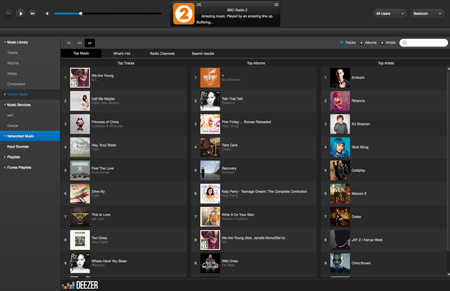
Simple Audio Roomplayer: Internet music services
TuneIn Radio gives you access to plenty of internet radio stations and you can also create a list of all your favourite stations, while We7 and Deezer (above) are also available for on-demand listening. Simple Audio is looking to add more music services in the future.
You can also stream music stored on your NAS drive, and all the files will show up in the Networked Sources section, which is a handy way of separating them from your iTunes library music. You can also create Simple Audio playlists for every occasion, using tracks from all sources.
If you’ve been playing music from your computer, the system switches inputs once you connect a portable player to the front input jack. It also automatically turns down the volume on your Controller so that there aren’t sudden increases in volume when changing source.
This can be a bit of a hassle, as you’ll have to flit between the Controller and iPod/MP3 player volume controls to make sure that you’re getting sound. If you can’t hear anything, re-connecting and double-checking all the settings are correct, adjusting the volumes, and pressing play on both interfaces should do the trick.
The Desktop Controller interface aims to be an intuitive affair – it’s design is sleek and simple, and will be an easy transition for anyone familiar with iTunes.
The music library is sorted into Tracks, Albums, Artists and Composers, and you have different viewing options for all your tracks – thumbnails, lists and a combination of the two.
However, when flicking in between, say, Tracks and Albums, the Controller doesn’t remember your viewing preference, reverting back to a default thumbnail size – which can be somewhat annoying for daily use.
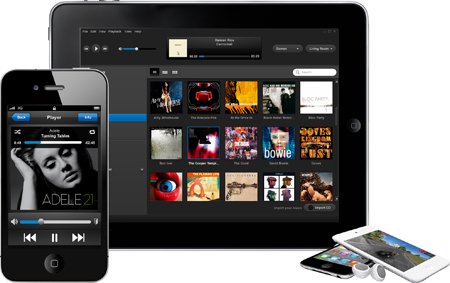
There’s also a free iOS remote app that you can download and use to control nearly all options found on the Desktop Controller: you can select tracks, switch to radio and music services, and control playback and volume. You can also choose the user and which Roomplayer unit you’re controlling.
It doesn't respond quite as smoothly or swiftly to commands as, say, the Sonos iOS app, but it does the job.
A dedicated iPad version of the app, as well as an app for Android users, are also in the pipeline but weren't available at the time of review.
Also missing is a multiroom 'party' mode, allowing you to play the same music in sync in all rooms simultaneously, although Simple Audio says this is something it hopes to offer in the future.
Simple Audio Roomplayer: Sound quality
The Simple Audio system’s ability to play all popular file types is a huge point in its favour, as is its capability of playing 24-bit/96kHz audio.
There’s usually trade-off in audio quality with multi-room systems of this type, but Simple Audio aims to contest that – and when we pressed play, we were treated to a sound that was fast, precise and decently detailed.
The streaming is seamless and clear, with audio never dropping off as long as your network and mains wiring are stable.
Play Maroon 5’s This Love, and the Simple Audio does a fine job of delivering the upbeat track with precision and agility. It has plenty of punch and can go quite loud, yet still manages to keep everything under control without instruments and vocals getting confused.
The Simple Audio system has an even-toned presentation across all types of music. Treble never gets hard-edged, while bass remains taut and articulate.
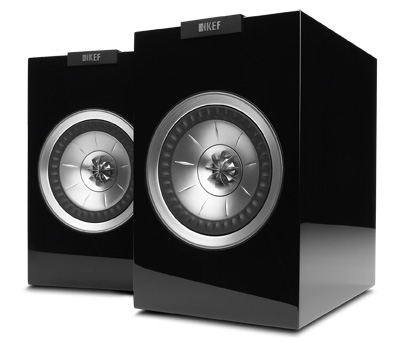
Simple Audio Roomplayer: Speakers
Another plus point is that it will drive a decent range of speakers, from the Q Acoustics 2010is (£120) to the KEF R100s (£600, shown above). However, its pared-back sound means that some care must be taken when partnering with speakers: the KEF R100s, for example, are a great match.
Their sweet presentation and expressive midrange will lift the spirits of the Simple Audio system, injecting it with a dose of enthusiasm that makes it sound all the more musical and entertaining.
For all that precision, though, the system doesn’t really compel you to sit down and just enjoy the music. All songs have their individual music character and shade of emotion – and a lack of transparency here diminishes that edge; it just doesn’t have that extra level of detail that lets you properly engage with the music.
John Williams’s Jurassic Park Theme is one of our favourite test tracks – a demanding score to test even the best of systems. The Simple Audio system doesn’t fully convey the dynamic shifts that accompany the sweeping orchestral music, though, and this diminishes the emotional connection with the listener.
It also can’t quite reach a level of refinement that would convey the last word in nuances and richness. Play York-based blues rock band Hijak Oscar’s Bitter Carnival, and while lead vocalist Tim Fox’s Tom Waits-inspired vocals have the right amount of rasp and gravel, we weren’t convinced by the amount of aggression and tension delivered by the Roomplayer I.
It’s an interesting time for computer-based music. Products like the Audio Pro LV2e and Jawbone Big Jambox speaker systems might not look like direct rivals for the Simple Audio system, but they both have wireless capabilities, stream music from your computer/iPod, and they are also multiroom systems.
And while both of these still have room for improvement to deliver the kind of sonic quality that even budget hi-fi separates are able to, they are exciting and fun to listen to.
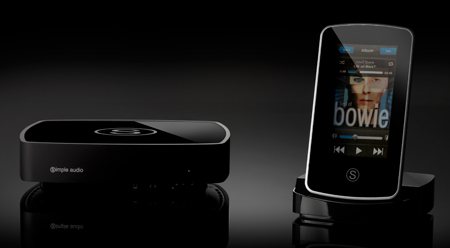
Simple Audio Roomplayer: Verdict
Until now, the default option for anyone wanting a relatively affordable 'plug and play' multiroom set-up has tended to be Sonos. That system has focused on being more of a lifestyle experience, with its intuitive interface and Spotify, Napster and Last.fm integration.
Big names like that are bound to attract consumers, even if it doesn’t play 24-bit/96kHz like the Simple Audio.
Simple Audio gives us a welcome alternative at a similar price, but with the focus on delivering better-quality audio – and in this it succeeds to a certain extent. It still has a few bridges to cross, but it’s a decent-sounding system that is well worth an audition.
What Hi-Fi?, founded in 1976, is the world's leading independent guide to buying and owning hi-fi and home entertainment products. Our comprehensive tests help you buy the very best for your money, with our advice sections giving you step-by-step information on how to get even more from your music and movies. Everything is tested by our dedicated team of in-house reviewers in our custom-built test rooms in London, Reading and Bath. Our coveted five-star rating and Awards are recognised all over the world as the ultimate seal of approval, so you can buy with absolute confidence.
